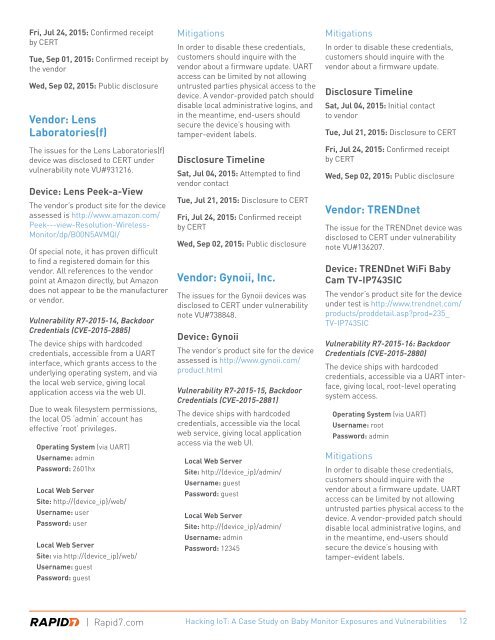HACKING IoT A Case Study on Baby Monitor Exposures and Vulnerabilities
RL2Fq
RL2Fq
Create successful ePaper yourself
Turn your PDF publications into a flip-book with our unique Google optimized e-Paper software.
Fri, Jul 24, 2015: C<strong>on</strong>firmed receipt<br />
by CERT<br />
Tue, Sep 01, 2015: C<strong>on</strong>firmed receipt by<br />
the vendor<br />
Wed, Sep 02, 2015: Public disclosure<br />
Vendor: Lens<br />
Laboratories(f)<br />
The issues for the Lens Laboratories(f)<br />
device was disclosed to CERT under<br />
vulnerability note VU#931216.<br />
Device: Lens Peek-a-View<br />
The vendor’s product site for the device<br />
assessed is http://www.amaz<strong>on</strong>.com/<br />
Peek---view-Resoluti<strong>on</strong>-Wireless-<br />
M<strong>on</strong>itor/dp/B00N5AVMQI/<br />
Of special note, it has proven difficult<br />
to find a registered domain for this<br />
vendor. All references to the vendor<br />
point at Amaz<strong>on</strong> directly, but Amaz<strong>on</strong><br />
does not appear to be the manufacturer<br />
or vendor.<br />
Vulnerability R7-2015-14, Backdoor<br />
Credentials (CVE-2015-2885)<br />
The device ships with hardcoded<br />
credentials, accessible from a UART<br />
interface, which grants access to the<br />
underlying operating system, <strong>and</strong> via<br />
the local web service, giving local<br />
applicati<strong>on</strong> access via the web UI.<br />
Due to weak filesystem permissi<strong>on</strong>s,<br />
the local OS ‘admin’ account has<br />
effective ‘root’ privileges.<br />
Operating System (via UART)<br />
Username: admin<br />
Password: 2601hx<br />
Local Web Server<br />
Site: http://{device_ip}/web/<br />
Username: user<br />
Password: user<br />
Local Web Server<br />
Site: via http://{device_ip}/web/<br />
Username: guest<br />
Password: guest<br />
Mitigati<strong>on</strong>s<br />
In order to disable these credentials,<br />
customers should inquire with the<br />
vendor about a firmware update. UART<br />
access can be limited by not allowing<br />
untrusted parties physical access to the<br />
device. A vendor-provided patch should<br />
disable local administrative logins, <strong>and</strong><br />
in the meantime, end-users should<br />
secure the device’s housing with<br />
tamper-evident labels.<br />
Disclosure Timeline<br />
Sat, Jul 04, 2015: Attempted to find<br />
vendor c<strong>on</strong>tact<br />
Tue, Jul 21, 2015: Disclosure to CERT<br />
Fri, Jul 24, 2015: C<strong>on</strong>firmed receipt<br />
by CERT<br />
Wed, Sep 02, 2015: Public disclosure<br />
Vendor: Gynoii, Inc.<br />
The issues for the Gynoii devices was<br />
disclosed to CERT under vulnerability<br />
note VU#738848.<br />
Device: Gynoii<br />
The vendor’s product site for the device<br />
assessed is http://www.gynoii.com/<br />
product.html<br />
Vulnerability R7-2015-15, Backdoor<br />
Credentials (CVE-2015-2881)<br />
The device ships with hardcoded<br />
credentials, accessible via the local<br />
web service, giving local applicati<strong>on</strong><br />
access via the web UI.<br />
Local Web Server<br />
Site: http://{device_ip}/admin/<br />
Username: guest<br />
Password: guest<br />
Local Web Server<br />
Site: http://{device_ip}/admin/<br />
Username: admin<br />
Password: 12345<br />
Mitigati<strong>on</strong>s<br />
In order to disable these credentials,<br />
customers should inquire with the<br />
vendor about a firmware update.<br />
Disclosure Timeline<br />
Sat, Jul 04, 2015: Initial c<strong>on</strong>tact<br />
to vendor<br />
Tue, Jul 21, 2015: Disclosure to CERT<br />
Fri, Jul 24, 2015: C<strong>on</strong>firmed receipt<br />
by CERT<br />
Wed, Sep 02, 2015: Public disclosure<br />
Vendor: TRENDnet<br />
The issue for the TRENDnet device was<br />
disclosed to CERT under vulnerability<br />
note VU#136207.<br />
Device: TRENDnet WiFi <strong>Baby</strong><br />
Cam TV-IP743SIC<br />
The vendor’s product site for the device<br />
under test is http://www.trendnet.com/<br />
products/proddetail.asp?prod=235_<br />
TV-IP743SIC<br />
Vulnerability R7-2015-16: Backdoor<br />
Credentials (CVE-2015-2880)<br />
The device ships with hardcoded<br />
credentials, accessible via a UART interface,<br />
giving local, root-level operating<br />
system access.<br />
Operating System (via UART)<br />
Username: root<br />
Password: admin<br />
Mitigati<strong>on</strong>s<br />
In order to disable these credentials,<br />
customers should inquire with the<br />
vendor about a firmware update. UART<br />
access can be limited by not allowing<br />
untrusted parties physical access to the<br />
device. A vendor-provided patch should<br />
disable local administrative logins, <strong>and</strong><br />
in the meantime, end-users should<br />
secure the device’s housing with<br />
tamper-evident labels.<br />
| Rapid7.com Hacking <str<strong>on</strong>g>IoT</str<strong>on</strong>g>: A <str<strong>on</strong>g>Case</str<strong>on</strong>g> <str<strong>on</strong>g>Study</str<strong>on</strong>g> <strong>on</strong> <strong>Baby</strong> M<strong>on</strong>itor <strong>Exposures</strong> <strong>and</strong> <strong>Vulnerabilities</strong> 12


